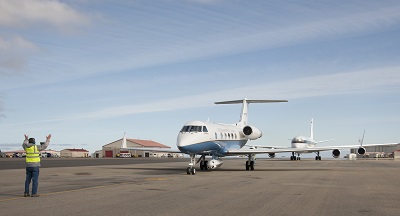Radar Used to Determine Oil Spill Thickness
NASA participated for the first time in Norway's annual oil spill cleanup exercise in the North Sea on June 8 through 11. The aim was to follow-up on spill response technology evaluated during the Deepwater Horizon spill of 2010.
Scientists flew a specialized NASA airborne instrument called the Uninhabited Aerial Vehicle Synthetic Aperture Radar (UAVSAR) on NASA's C-20A piloted research aircraft to monitor a controlled release of oil into the sea, testing the radar's ability to distinguish between more and less damaging types of oil slicks.
In the exercise, oil was released onto the ocean and then recovered.
"This year was special, because we had our own dedicated science experiment in the middle of the training exercise," said Camilla Brekke, associate professor in the Department of Physics and Technology at the University of Tromsø, Norway.
Brekke, and colleagues from NASA and the California Institute of Technology, recognized UAVSAR's potential to classify oil during observations of the Deepwater Horizon spill. As they had only estimates of how much oil was released in the disaster and of the rate of flow, they could not fully check UAVSAR's accuracy. The Norwegian study gave them the chance to do that.
The same accident can create both sheens of oil a few hundredths of an inch thick and heavy, sticky emulsions of oil and seawater, depending on factors such as the weather and length of time since the spill.
 Radars see an oil spill because of a characteristic that the Greek philosopher Aristotle first wrote about 2,500 years ago: pouring oil on water smooths the surface. To an observer, returning radar signals, called backscatter, from a smooth, oily sea surface look darker than backscatter from a normal sea surface with small, bumpy waves.
Radars see an oil spill because of a characteristic that the Greek philosopher Aristotle first wrote about 2,500 years ago: pouring oil on water smooths the surface. To an observer, returning radar signals, called backscatter, from a smooth, oily sea surface look darker than backscatter from a normal sea surface with small, bumpy waves.
During their observations of the Gulf oil spill, the NASA scientists discovered that the extremely sensitive UAVSAR could also detect another characteristic of oil: compared with seawater, it is a very poor conductor of electricity. Radar waves are reflected well by materials with good electrical conductivity, such as seawater, and not so well by poor conductors like oil. For that reason, the strength of the backscatter from different parts of an oil slick is related to the thickness of the emulsion in each part.
The Norwegian exercise released emulsions of differing thicknesses so that the scientists could have a range of conditions to calibrate the UAVSAR data. The experiment also tested the instrument's ability to distinguish between petroleum and plant-based oil, found in algal blooms. "In the Baltic Sea you will see plenty of these, and they look like oil slicks from [radar on] a satellite," Brekke said.
Brekke’s hopes that in future the technology can be used to identify where high-environmental-impact oil is so cleanup crews can get the most out of the time and people they have.
Norway is one of a few nations worldwide that allow oil to be discharged at sea to test new cleanup technologies and procedures. The Norwegian Clean Seas Association for Operating Companies runs the Oil on Water exercise, as well as more than 100 other annual drills in which no oil is released, to keep its personnel and ships ready to respond to an emergency.
This year, Oil on Water was held at the abandoned Frigg Oilfield, about 140 miles (230 kilometers) northwest of Stavanger, Norway.
